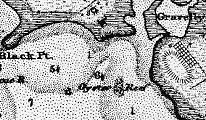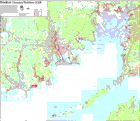Related Pages: Shellfish Bed closures | Red Tide Closures | CCMP Action Plan 2: Protecting and Enhancing Shellfish Resources
Note: Much of the information on this page is from the Massachusetts Division of Marine Fisheries site which contains the most up to data information.
Where are the shellfish beds in Buzzards Bay?
Nearly every harbor in Buzzards Bay has some good shellfish beds. Most shellfishing occurs very close to shore, particularly in the harbors. There is also some dredging for shellfish, mostly quahogs, in deeper waters offshore.
In the map below are the most pronounced concentrations of commercial and recreational species. This map was developed by the Massachusetts Division of Marine Fisheries to show “shellfish suitability areas.”
Link to a nautical chart with shellfish suitability areas.
Shellfish Permit Information
You must obtain a shellfish harvesting permit at your town or city hall before you collect shellfish. Two basic permits are available: recreational and commercial permits. Recreational permits may include resident, non-resident, family, and seniors. Below is a summary for Buzzards Bay towns. Not all possible permits shown. Contact your town for the latest fee rates.
| Municipality | Commercial | Recreational: Resident | Recreational: Non-Resident | Temporary Non-Resident | Senior | on line regs | Phone for Information (all 508) |
| Bourne (1) | $625 | $35 | $175 | NA | $10 | yes | 759-0621 |
| Dartmouth | $225 | $15 | $75 | NA | free at 65 | no | 910-1819 |
| Fairhaven | $250 | $22 | $125 | NA | free at 62 | Shelfish Regs Quahog Dredging | 979-4023 |
| Falmouth | $200 | $20 | $50 | NA | $5 at 65 | yes | 495-7334 |
| Marion & Rochester | $150 | $25 | $120 | $25 (30 days) | free at 70 | no | 748-3535 |
| Mattapoisett (2) | $225 | $12 | $125 | NA | free at 65 | no | 758-4100 |
| New Bedford (3) | $225 | $12 | $50 | NA | $3 at 59 | no | 979-1450 |
| Wareham (4) | $900 | $30 | $120 | $30 (2 weeks) | $15 at 65 | yes | 291-3100 x3186 |
| Westport | $100 | $25 | $100 | NA | $10 at 65 | no | 636-1105 |
| (1) Commercial Fee for Masters License, quahog $250, clam $250, scallop $250, apprentice $100 | |||||||
| (2) Quahog Commercial License : $200 with boat, $100 with no boat. | |||||||
| (3) Quahog only taking allowed, commercial price for full year. | |||||||
| (4) Commercial Fee for Masters License, quahog $400, scallop $400, oyster $400 clam $300, eel $100 | |||||||
What are the size and quantity limits for the taking of shellfish
The table below summarizes the recreational size limits for shellfish, including crustaceans. These are subject to change, and you should consult your municipal shellfish warden. See the latest information at this DMF page.
| Recreational Shellfish Regulations | ||
| Species | Minimum Size | Other Restrictions |
| Blue Crab | 4 1/8″ shell width (spine to spine) | egg bearers cannot be taken; 50 crabs/day; no permit required unless using traps; closed season is 1/1 – 4/30, inclusive |
| Other Edible Crabs (excludes green crabs) | none | same as for blue crab |
| Lobster | 3 3/8″ carapace length for Southern New England. See DMF page. | egg bearers cannot be taken; v-notched female lobster cannot be taken; state license required |
| Bay Scallop | well defined growth ring | Closed 4/1 – 10/1/09 consult town regulations |
| Conch | 2 3/4″ shell width | consult town regulations |
| Oyster | 3″ shell diameter | consult town regulations |
| Quahog | 1″ shell thickness | consult town regulations |
| Sea Scallop | 3 1/2″ shell height | daily limit of 1 bushel in shell, or 4 quarts of shucked meats |
| Softshell Clam | 2″ shell diameter | consult town regulations |
| Surf Clam | 5″ shell diameter | consult town regulations |
Regulations are subject to change. Contact the Division of Marine Fisheries for details (617) 626-1520 or visit the MA DMF website for updates and Commercial Limits.
Where are the bacterial closures?
Many areas of Buzzards Bay have been closed to shellfish due to bacterial closures. Some of these closures are permanent (year-round), seasonal (summertime), or rainfall conditioned. For example, the closures at the end of Clarks Point in New Bedford, and East of Mishaum Point in Dartmouth are permanent closures because of municipal sewage treatment facility discharges in those areas. Other areas like Sippican Harbor in Marion and West Falmouth Harbor in Falmouth are closed because of elevated bacteria levels or high densities of boats moored during the summer. Most closures around Buzzards Bay are the result of “non-point” land based sources, often conveyed by stormwater runoff.
Go to our Current Shellfish Closures page for more information
Are Conditions getting Better or Worse?
Because of the hard work of Buzzards Bay municipalities and the Massachusetts Division of Marine Fisheries to address stormwater and other pollution problems, the acreage of permanently closed shellfish beds in Buzzards Bay declined dramatically during the 1990s. The Buzzards Bay NEP helped contribute to this effort through our grant and technical assistance programs. However, recent trends heavy been less positive, and through most of the 2000s, only modest reductions occurred in the reduction of areas permanently closed. At the end of 2008 however, the Massachusetts opened 1,100 acres of outer New Bedford harbor, which has been a particular boom to the Fairhaven shellfish fishery. Go to our Current shellfish bed closures page to learn more.
Links
Coastal Water Quality Program at the Massachusetts Coastal Zone Management Program
CZM is working with federal and state agencies, local officials, industry representatives, environmentalists, and the public to develop enforceable measures to restore and protect coastal waters from nonpoint source (NPS) pollution, which is currently the number one pollution problem in U.S. coastal waters. NPS pollution occurs when contaminants are picked up by rain water and snow melt and carried over land, in groundwater, or through drainage systems to the nearest water body.
Belding Historical Documents
These reports produced by David Belding in the early 20th century are of interest to anyone studying the historical changes of fisheries in Massachusetts. Note that the spelling for quahog differed at the time.
Belding, D. L. 1909 A report upon the mollusk fisheries of Massachusetts. Wright & Potter, Boston, MA, 234 pp.download pdf of 598 page version, 22.4 MB) or download pdf of 350 page version, 41.8 MB).
Belding, D. L. 1910. A report upon the scallop fishery of Massachusetts. including the habits. life history of Pecten irradians, its rate of growth, and other facts of economic value. Wright & Potter Printing Co., Boston. 150 pp. download pdf (11.4 MB)
Belding, D.L., 1910. Scallop studies on Cape Cod, MA, Mass. D.M.F. report, 200 pp.
Belding, D.L., 1910. The scallop fishery of Massachusetts: including an account of the natural history of the common scallop. Boston, MA: Commonwealth of Massachusetts Commission on Fisheries and Game, Marine Fisheries Series No 3. 51pp. (Reprinted in 1931 and 1964, possibly with a shortened title).
Belding, D.L. 1910. The growth and habits of the sea clam (Mactra solidissima). Rep. Comm. Fish. Game Mass 1909 Publ. Doc. 25:26-41.
Belding, D. L., 1911. The life history and growth of the quahaug (Venus mercenaria). Ann. Rep., Comm. Fish and Game, Massachusetts, 1910, pp. 18-128.
Belding, D. L., 1911. The Lobster Fishery. A Special Report Including Suggestions for Uniform Laws Made to the Legislature of Massachusetts by the Commissioners on Fisheries and Game. download pdf (3.6 MB)
Belding, D. L. 1911. A report upon the quahaug and oyster fisheries of Massachusetts, including the life history, growth and cultivation of the quahaug (Venus mercenaria), and observations on the set of oyster spat in Wellfleet Bay. Massachusetts Division of Marine Fisheries Contribution #12: 134 pp. (This might have been the actual internal report in 1911, but the 1912 copy by Wright and Potter is the one that was widely distributed.)
Belding, D. L. 1912. A report upon the quahaug and oyster fisheries of Massachusetts, including the life history, growth, and cultivation of the quahaug (Venus mercenaria), and observations on the set of the oyster spat in Wellfleet Bay. Wright and Potter Printing Co., Boston, 134 p.
Belding, D.L., 19l2. (Reprint l964) A report upon the quahog and oyster fisheries of Massachusetts. Mass. Div. Fish. Game, l34 pp.
Belding, D.L. 1921. A report upon the alewife fisheries of Massachusetts. Marine Fisheries Ser. No. 1. Massachusetts Division of Marine Fisheries. 135 pp. download pdf (16 MB)
Belding, D.L., 1921. (Reprint l964) A report upon the alewife fisheries of Massachusetts. Mass. Div. Fish. Game, l35 pp.
Belding, D. L., 1930. The soft-shelled clam fishery of Massachusetts: including the natural history of the soft-shelled clam and a discussion of sewage pollution and shellfish. Boston: Commonwealth of Massachusetts, Dept. of Conservation, Division of Fisheries and Game, Marine Fisheries Section, 65 p. ill. (Marine fisheries series ; no. 1) (also cited as 135 pages, probably from when the figure plates are counted)
Belding, D. L. 1931. The quahaug fishery of Massachusetts: including the natural history of the quahaug and a discussion of quahaug farming. [Boston] : Commonwealth of Massachusetts, Dept. of Conservation, Division of Fisheries and Game, Marine Fisheries Section, 41 p. : ill. (Marine fisheries series ; no. 2).
Belding, D.L., 1931. (Reprint l964) The scallop fishery of Massachusetts. Mass. Div. Fish. Game , 3:5l.
Belding, D.L., 1931. The Quahaug Fisheries of Massachusetts. Marine Fisheries Series No. 2. Massachusetts Division of Marine Fisheries, 4l pp.

Oyster Reef shown on an 1882 Sippican Harbor (Marion, MA) nautical chart.
Historic charts sometimes contain information on the location of oyster reefs and eelgrass beds. Go to our webpage on using historical aerial photographs and charts for more information. Under the heading Historic Maps, the link to the Office of Coast Survey’s Historical Map and Charts is among the most useful.
Links to Current Information
More recent reports and information on fish and shellfish catch statistics can be found at the Massachusetts Division of Marine Fisheries website including their Technical Reports page.

